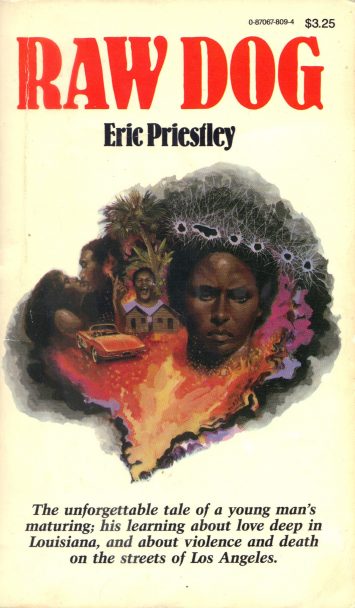 By ERIC PRIESTLEY (Holloway House; 1985)
By ERIC PRIESTLEY (Holloway House; 1985)
This is very likely the finest novel ever published by the paperback outfit Holloway House. As with most Holloway books, RAW DOG was written by a African-American man and released with lurid cover art highlighting the story’s more exploitable elements. The novel, however, is far richer and more thoughtful than it might seem, being (I’m told) an autobiographical account by a prominent African American poet of his upbringing in the 1950s.
The novel’s orientation is established in the opening pages, in which the narrator, Johnny, recounts his earliest memory: of biting a chunk out of another kid’s cheek at age one, during which “I must have broken an artery, because there was blood everywhere.” Johnny, it transpires, is a sensitive and artistic soul, yet violence is an ever-present fact of his reality, triggering an inner struggle that pits Johnny’s refined nature against his baser impulses; given the rawness of his surroundings, you can probably guess which of those two extremes is favored by most everyone around him.
We follow Johnny until age seventeen, experiencing life in Compton and Watts, CA—a.k.a. the ghetto—where his impoverished family has relocated from Louisiana. His upbringing is presided over by a loving mother and a loutish father who disdains Johnny’s burgeoning appreciation of art and literature. Johnny also has a deep affinity for the natural world, bequeathed by periodic family trips to his rural Louisiana hometown. Back in California, though, things are quite bleak, with Johnny forced to contend with gang warfare, family feuds, sadistic teachers, a delinquent little brother and carnivorous rodents, in addition to the blatant racism that pervaded 1950s America. Johnny longs to escape this nightmarish existence, but how?
All this is set down in admirably blunt, straightforward prose that nonetheless fully evinces the author’s poetic bent. The street slang of Johnny’s surroundings often makes its way into the text, but not to the point that it ever compromises the book’s readability (although the frequent use of clichés is unfortunate). And yes, the starkness of Eric Priestley’s vision fully encompasses the brutality suffusing the novel, which is often quite harsh and disturbing, making for a child-centered story that’s strictly an adults-only reading experience.
